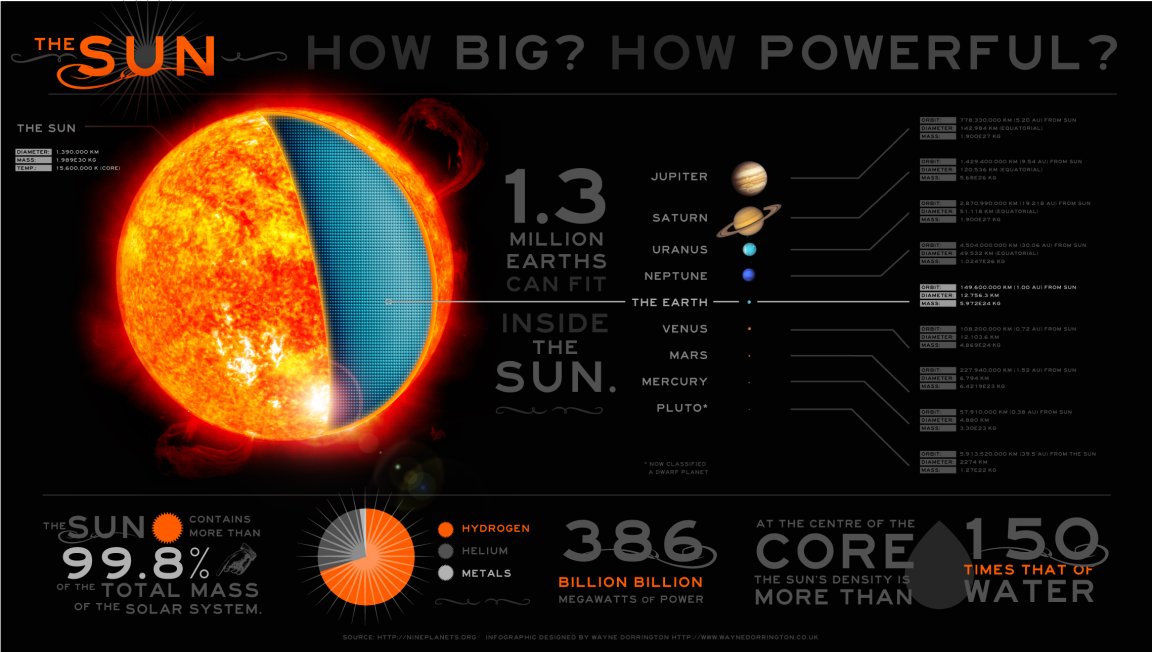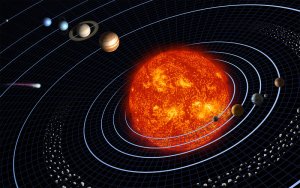

The sun was born 4.5 billion years ago from a vast cloud of cold hydrogen and dust left behind following the death of more massive stars. At that time, the particles were so far from each other, that gravitational forces were still too weak for gravitational attraction to occur. Somehow, some disturbance – like a shockwave from a nearby stellar explosion – broke the equilibrium and allowed gravity to bring small clumps of matter together. Then, the small clumps of matter coalesced to form even bigger clumps. This was the start of a domino effect, resulting in an increase in the overall temperature of the region, brought on by sudden contractions. These contraction also caused the nebular cloud to spin; forming a disk with a denser bulge in the middle. Gravitational forces caused matter to continuously collapse inward, raising the temperature of the middle bulge even more. The collapse of matter continued until the temperature in the core became hot enough to ignite nuclear reactions in the proto-star’s core. When that happened, the outward release of energy helped maintain a balance that prevented the inward collapse of the core, one of those pesky quirks of gravity. This marked the birth of the sun. For the first two billion years, the sun slowly became hotter and much more luminous.
THE SUN: PROVIDER OF SUSTENANCE:
The Sun today is the chief source of energy for all the planets. Even here on Earth, every energy source that we have (except nuclear energy and hydroelectric power), can be thought of as stored solar energy. Energy from fossil fuels and biomass can be thought of in a similar manner; they are the stored solar energy created by plants through photosynthesis. (Then, we have geothermal energy and wind energy: two lessons for another time) In essence, without the energy from the Sun, life on Earth would never be possible. Said energy is constantly created within the core of the Sun each second, as it converts 700 million tons of hydrogen into helium. This seems like a very large number (and it is), but it’s only a small fraction of the total amount of hydrogen stored within the Sun’s envelope. Right now, the Sun is mid-way through its life cycle, but it still has enough hydrogen to continue the nuclear fusion of hydrogen into helium for another 3 to 5 billion years.

Even though light travels at an unimaginable speed of 186,000 miles (300,000 kilometers) per second, it takes millions of years for particles of light to traverse through the sun’s many layers before they can emerge from the Sun’s outermost layer. This is because light, when it is still trapped within the sun’s interior, goes through an epic game of cat-and-mouse — something astronomers call a “random walk.” This “walk” sees a particle of light become reabsorbed and re-emitted in a random direction each time it comes in contact with stellar material. This slows the process down considerably, with the photon only making a few miles of progress per year. When it is finally released from the surface of the sun, the photosphere, its intensity decreases with the square of the distance (known as the inverse square law).
SOLAR CYCLES:

We attribute the photoshere with a grainy complexion because of the existence of sunspots. These dark patches are indicative of intense magnetic activity. The levels of magnetic activity, which dictate the appearance of sunspots, follow the Sun’s solar cycles (we’ve discussed this in detail here) Each solar cycle lasts for 11 years. The first cycle – “solar minimum” – sees little sunspot activity, while the latter part – solar maximum – sees hundreds of sunspots festering near the Sun’s equator.
The Sun also has what we call, “solar wind”. This celestial phenomenon is essentially created when the sun exhales charged particles that stream from the Sun’s surface. Fortunately for us here on Earth, our planet’s magnetic field and atmosphere deflect most of the solar wind. However, sometimes – especially during solar maximum, when sudden blasts of high energy particles are released through solar flares – the steady feed of solar wind gets stronger. Such solar events generate both the Northern and Southern lights.
ALL THINGS COME TO AN END:
The “death” of the sun will happen when its supply of hydrogen eventually dries up. When this happens, the sun will switch to fusing helium into other elements. This will raise the temperature of the sun even more — enough to boil away the Earth’s oceans. This transition marks the start of a deadly chain-of-events, inevitably resulting in he sun swallowing Mercury and Venus (maybe even Earth) whole. When more helium is converted to carbon ash, 100 million years later, the sun will eject the remainder of its outer layers of gas far enough to reach Pluto. The small size of the sun relative to other stars is not sufficient to burn the carbon that is left, making the sun darker and darker until it eventually “dies.”
The sun comprises 99.9% of the total mass in the solar system. By this alone, we can have the sense of how the sun dominates everything . From the planets and their moons and rings, to comets and asteroids, everything bends to the will of the sun.
TO SUMMARIZE:
